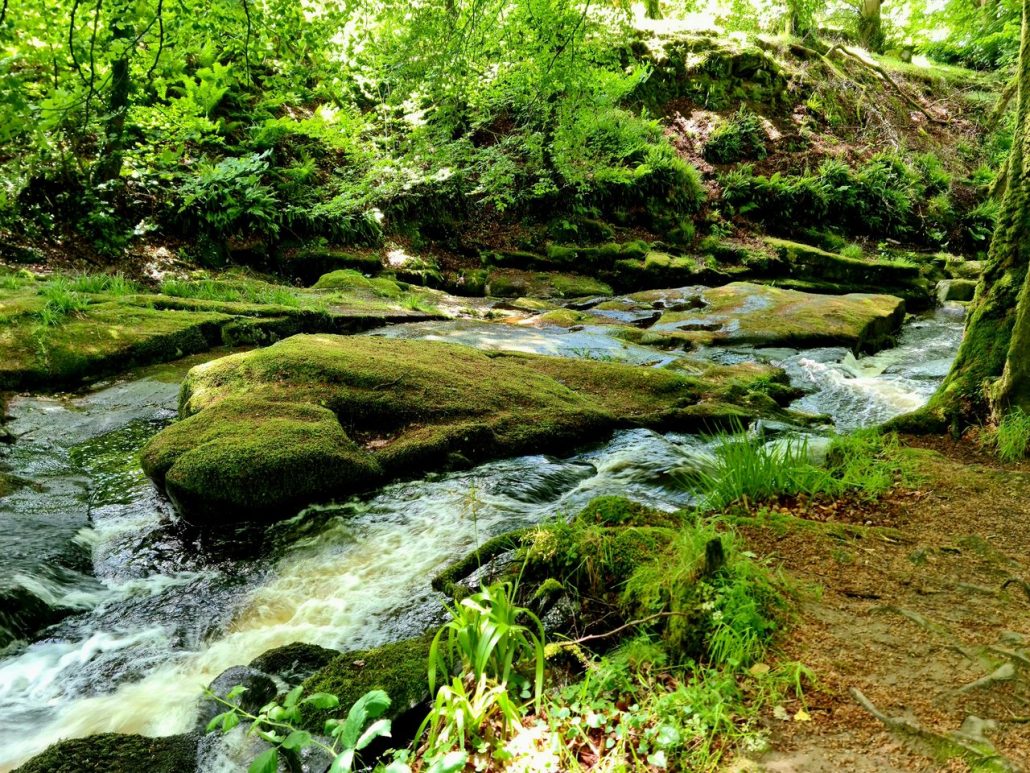Back in the day, when anyone mentioned Wicklow, the inevitable tagline of ‘the garden of Ireland’ would immediately follow. It truly is a beautiful county, with breathtaking scenery, stone houses, and the occasional oddity, such as Cloughleagh Bridge and the Coronation Plantation, that only adds to its interest

Cloughleagh Bridge is a 200-year-old single-arch bridge that spans the ambitious Shankill River, which is really a stream. Those who know more than I do about such things describe it thus:
The bridge is rubble-constructed with dressed granite voussoirs to the semi-circular arch. The parapets are also largely in rubble, but both have an unusual somewhat ‘rustic’ central balustrade section consisting of plain squat square granite balusters arranged corner to corner, and a plain granite rail.
For me, it marks a little piece of paradise that in autumn is a popular spot among nature photographers. The light and the colours had me humming Johnny Cash’s 40 Shades of Green.


Wending our way onwards, we passed a local church. The service was in full swing so I didn’t want to interrupt. I was struck, not for the first time, at how rooted Christianity is in Ireland and how these stone edifices still stand tall, despite the waning popularity of religion.

The county of Wicklow has the highest forest cover in Ireland; most of it is man-made. There’s a uniformity to it. Great swathes of tall trees marked the hillsides, which, if seen from above, would appear as dark green squares or rectangles, with clearly defined angles. But occasionally, there’s a randomness that stands out. Like the Coronation Plantation.


These trees were planted back in 1831 and got their name because, in that same year, William IV became king of Britain and Ireland. One of the main landlords in Ireland at the time was a chap called the Marquess of Downshire. [Dick Warner, writing for the Irish Examiner back in 2007 notes that at the time, just a dozen men owned a quarter of the land in the country.] He was a fan of the Irish language and was president of the Ulster Gaelic Society. He was also Colonel of the South Down Militia.
The 3rd Marquess, Arthur Hill, was obviously well connected as he was part of the coronation party, carrying the second sword at the ceremony in September of 1831.
At the time, he would have owned Blessington Estate in Co. Wicklow. Like many of his ilk, at the time he was wondering how he could make the most of their estates. Even back then it was all about the money. Producing timber for commercial use was hit on as something to try.
Some 2000 years earlier. the last of the Scots pine trees in Ireland had gone to tree heaven. Inspired by how it was thriving in Scotland, the Marquess imported saplings and planted them in the Wicklow uplands. Some 500 acres all told.
Perhaps Mother Nature has taken a hand in the thinning of the woods but these trees look like they were plopped down by someone with more of an eye on nature than on profit. Today, the Scots pine co-exists happily with the native Irish oak, safe in the knowledge that they’re unlikely ever to see the wrong side of an axe.
That said, the original plans show the plantation as a large rectangle. Perhaps it was never finished.

The area is popular for birdwatching with Whinchats and Cross Bills calling it home, with their neighbours the Sika deer and the red squirrel.
Sadly, as Warner writes, its days are numbered.
And the Coronation Plantation is almost certainly doomed. There is no natural regeneration of young trees. This is partly because any seedlings are browsed down by sheep, deer and hares. But it’s also because natural regeneration in the Caledonian Pine Forest of the Highlands of Scotland is aided by cones being blown across hard-packed snow and ice in winter storms. Scottish pine groves always spread down wind. The milder climate and lower altitude in Wicklow seldom produce these conditions.
Historically there has been some felling in the Coronation Plantation, particularly in WWI and WWII, and there is loss from natural causes such as wind-blow, lightning strikes and heath fires.
The maximum life-span of a Scots pine is up to 350 years, so the trees planted in the 1830s are only middleaged, but nobody has planted any more and the numbers are slowly but steadily dwindling.
I’m grateful I got to see it. If you’re around Ballynabrocky, Co. Wicklow, keep an eye out for the obelisk, a monument to the planting and then look beyond.
Share this:
- Click to share on X (Opens in new window) X
- Click to share on Facebook (Opens in new window) Facebook
- Click to share on Pinterest (Opens in new window) Pinterest
- Click to share on LinkedIn (Opens in new window) LinkedIn
- Click to share on Reddit (Opens in new window) Reddit
- Click to share on WhatsApp (Opens in new window) WhatsApp
- Click to share on Pocket (Opens in new window) Pocket
- Click to share on Telegram (Opens in new window) Telegram
- Click to email a link to a friend (Opens in new window) Email







One Response